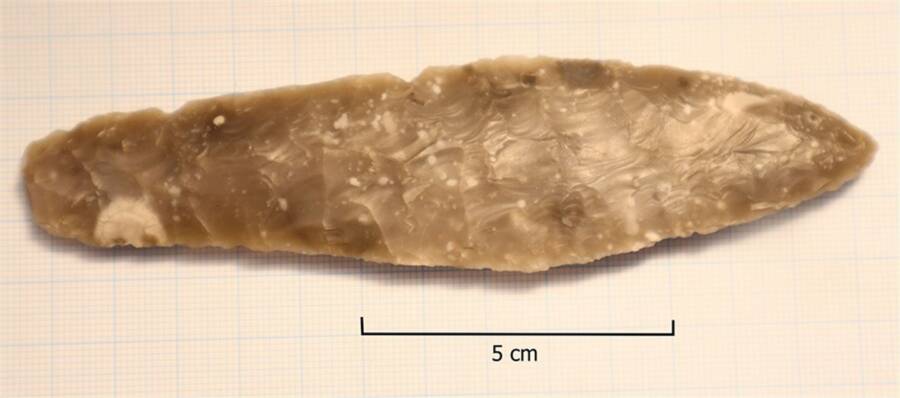An Eight-Year-Old Girl In Norway Just Found A Dagger From The Stone Age Outside Her School
The Stone Age dagger is made of flint, which is not naturally found in Norway, leading archaeologists to believe it may have been brought over from ancient Denmark.

Ayoung girl in Norway made a remarkable discovery while playing outside near her school — a 3,700-year-old flint dagger crafted by humans during the Stone Age.
The eight-year-old, identified only as Elise, said in a statement translated from Norwegian, “I was going to pick up a piece of glass, and then the stone was there. It was nice.”
Excited by the find, Elise showed the stone object to her teacher, Karen Drange. Dragne noted, however, that the nearly five-inch-long object was no mere stone — in fact, it looked ancient. More curiously, it was made of flint, a hard sedimentary rock not naturally found in Norway.
It is a grayish-brown color, and the sharpened edges are jagged, indicating that it may have been struck repeatedly.
Drange contacted the Vestland County Council, as is required when potential traces of prehistoric activity are discovered.
The council enlisted the help of archaeologist Louise Bjerre Petersen, who examined the object. “The stone is a beautiful flint dagger from the Neolithic period. It is an incredibly fine dagger, which is very rare to find,” he said.
The Vestland County Council then cooperated with the University Museum in Bergen to further examine the area around the Os school, where Elise found the ancient dagger.
“We found neither more objects nor traces of the Stone Age right here,” Petersen said, “but the dagger Elise found is quite unique. It will contribute to further research into the Stone Age in Western Norway.”

According to research from the National Museum of Denmark, Stone Age flint daggers served a somewhat surprising purpose among Neolithic communities.
Other flint tools, like axes and knives for example, often served their expected purpose. They were used for everyday activities essential to life — chopping wood, cutting food, hunting, etc. — but daggers didn’t seem to serve any practical purpose. Rather, researchers believe they may have been “prestige objects” designed to indicate their owner’s status.
Prestige flint daggers first appeared toward the end of the Neolithic era, around the same time the Early Bronze Age began on the European continent. Bronze Age daggers likewise served as status symbols among early European communities, and experts believe that the flint daggers found in Denmark may have been imitations of these slightly more advanced metal daggers.
This brief period at the end of the Stone Age is sometimes referred to as the “Dagger Period,” as Danish flintworkers continued to hone their craft. And even as bronze became more widely used, flint daggers continued to be produced well into the Bronze Age.
Norwegian archaeologists believe the dagger found by Elise may very well have been brought to ancient Norway from Denmark across the North Sea. Now, it is being housed at the University Museum in Bergen.
No comments: